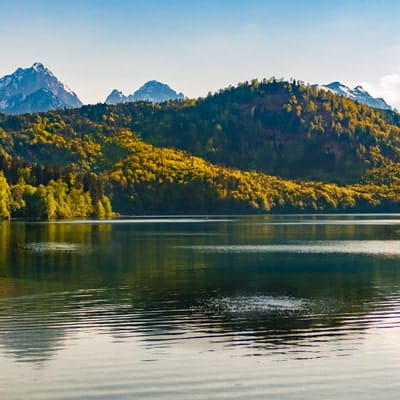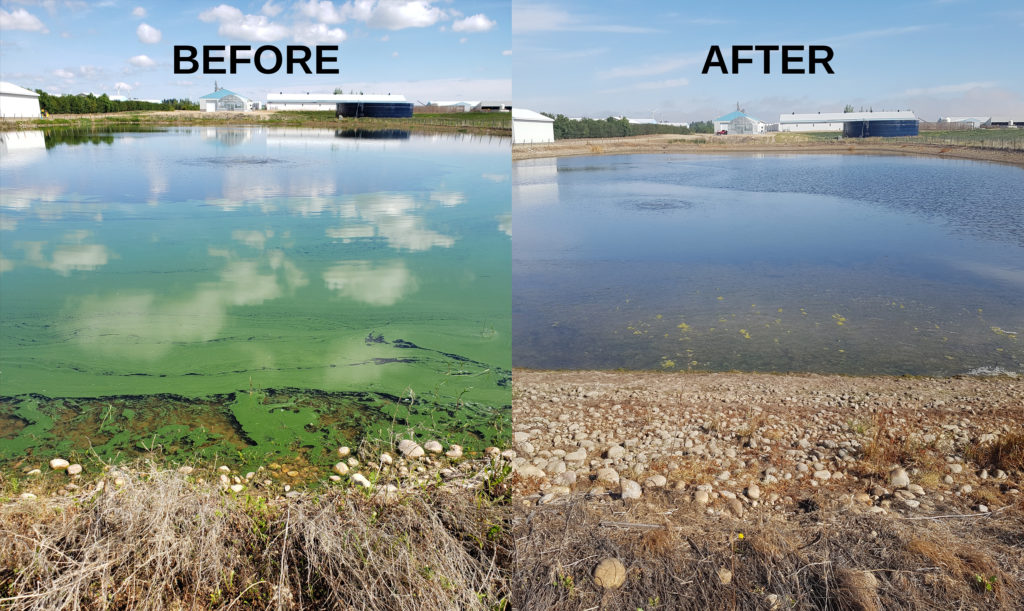We have been in the business of treating agricultural water for many years with great success and we have always said that you should fix problems as far up stream as possible. This includes dugouts and ponds. You rather want to prevent a problem from happening than to go fix a bigger problem. Aeration is always recommended as this will turn your dugout into an aerobic environment, keep your water fresher and less smell. Algae can cause your water lines and pumps to plug up but that’s not all. Algae causes pH to go up and anaerobic bacteria get stronger. Blue-green algae can be deadly to any life form.
Table of Contents
Aeration
Why Aerate

Aeration is all about gasses. Aeration mixes the pond so that toxic gasses are efficiently released and life-giving oxygen readily replaces it. An aerated pond will be clearer, cleaner, healthier, and have less muck at the bottom than a pond without aeration.
The science behind it:
Stratification
A pond without aeration will become stratified into two very separate layers in the summer heat. This is because of the physical properties of water. As the sun warms the surface water, it becomes less dense and thereby lighter than the cool water below it. The line at which these two layers separate (similar to oil floating on water) is called the thermocline.
No Oxygen = No Life

The vast majority of water-cleaning organisms (aerobic bacteria & phytoplankton) in a pond use oxygen to drive their metabolic processes. Oxygen enters the water column almost exclusively through the surface of a non-aerated pond. Because the surface water does not mix with the water below, oxygen in the bottom layer quickly becomes depleted under stratified conditions, allowing toxic gasses to build up. Because no oxygen is available below, the pond’s overall health will begin to suffer.
Nutrient Build-Up
Without water cleaning organisms on the bottom, any sediment, debris, and nutrients that enter the system fall to the bottom and accumulate. This layer on the bottom is what many refer to as “muck”. Having an unwanted pile of muck as well as a toxic lower-layer in your pond will quickly cause major headaches including algae blooms, rampant weed growth, and fish kills. Airmax® to the Rescue!

Our Airmax aeration systems utilize a shore-mounted air pump that delivers air to specialized diffuser plates that are located on the bottom of the pond. The resulting column of rising bubbles circulates water throughout the pond, eliminating the thermocline. With a fresh supply of oxygen, natural bacteria and phytoplankton go to work in the water column as well as on the bottom. Any excess nutrients in the system are metabolized, resulting in cleaner, clearer water and less muck. Results you can see in just 90 days!
Contact us for sizing and pricing.
Algae Control


Are you spending hard earned dollars every year on product to control algae in your dugout?
We offer a line of ultrasound equipment to control and kill algae. It’s a onetime investment in equipment. This equipment is for algae control in lakes (up to 120 acres/device), dugouts, pools, ponds, irrigation basins, clarifiers and sedimentation basins, UV chambers, distribution water tanks, Fresh and Marine Aquaculture.
- They can be powered by Solar: Land or SolaRaft -Pontoon based systems.
- Power supply systems (85-240 Volts, 50 or 60 Hz compatible DC – 24 Volts)
- Each power supply supports two ultrasonic units for dual operation.
The beauty of these units is you can either buy a really inexpensive unit called (Mezzo). The Mezzo units are cheaper but only work in a bi-directional fashion. They are good for usage in drainage or storage pipes or in areas that directional applications might work. Or you can buy the 360° version (Quattro). With 120 Acre coverage these are very good options, since return on investment (ROI) is huge.
What to expect after installation
Most blue-green algae, also known as cyanobacteria, will have lost their buoyancy and should be on, or settling to, the bottom of the pond within 3-4 days. The cells can be re-suspended via aeration, bringing them up to the light, which may prolong the time it takes for them to fully die off. Therefore, please note that a subsequent “bloom” is not uncommon, and it could take multiple cycles before a thorough algae remediation can occur.

Green algae (filamentous types) and colonial types require up to 3+ weeks before the damage results in them turning brown, depending on the kind (genus) of algae. They will normally float to the surface at this time due to the bacterial digestion process breaking them down. It takes about 7-10 days from that point before they are sufficiently digested to lose buoyancy and sink. Some users rake them out as the die-off begins or you may just let them settle to the bottom. If you do the latter, bioaugmentation can speed up the digestion process and help remove the biomass.
Diatoms react similarly to green algae but lose their mobility quickly, which hastens their dying process.
For biofilm control and prevention for water processing or treatment equipment, the ultrasound will be sensed by anaerobic bacteria as water turbulence. This will prevent the anaerobes from attempting colonization in a treated zone. Anaerobes start the process by forming a base layer of biofilm that the aerobic bacteria attach themselves to. Without this layer the bacteria cannot accumulate which, in turn, keeps the equipment walls cleaner for longer periods of time.
If the water is not going to be consumed by humans you can add our all-natural product called Airmax MuckAway. It is safe for animals but is not for human consumption. This will change the environment of the water so that the dead algae is consumed by aerobic bacteria.
- Green algae and diatom control range: 150 meters radially from the device or about 7 hectare or 17.5 acres.
- Blue-green algae with gas vesicles control range: 400 meters radially from the device or about 50 hectare or 124 acres.
- Frequency ranges:
- Bandwidth 1: low ultrasonic range starting at just above the normal hearing range of human beings
- Bandwidth 2: high ultrasonic range
- Total frequencies per cycle is greater than 1,000 frequencies
- Time per cycle: about 34 minutes.
- Power consumed: 11.2 watts average on 120 volts AC (about $15 per year at $0.15/kWh).
- Peak instantaneous power: 50 watts.
Contact us for sizing and pricing.
